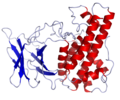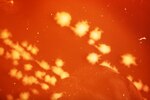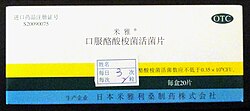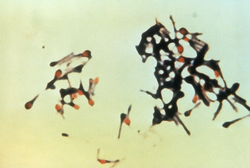Clostridium perfringens (formerly known as C. welchii, or Bacillus welchii) is a Gram-positive, bacillus (rod-shaped), anaerobic, spore-forming pathogenic...
72 KB (8,061 words) - 22:35, 25 May 2025
detection of C. perfringens and other pathogenic bacteria. Clostridium species are readily found inhabiting soils and intestinal tracts. Clostridium species are...
25 KB (2,498 words) - 09:43, 30 March 2025
Clostridium perfringens alpha toxin is a toxin produced by the bacterium Clostridium perfringens (C. perfringens) and is responsible for gas gangrene and...
5 KB (434 words) - 00:23, 15 December 2022
in the colostrum. Clostridium perfringens beta toxin shows significant genetic homology with several other toxins. C. perfringens beta toxin shows 28%...
8 KB (857 words) - 11:25, 18 August 2023
septicum can cause gas gangrene, but unlike other Clostridium species like Clostridium perfringens, no trauma is necessary at the site of the infection...
19 KB (1,990 words) - 16:22, 30 April 2025
that cause the outbreak which had affected over 700 people as Clostridium perfringens. This food borne outbreak has been called the worst incident to...
179 KB (16,683 words) - 03:02, 11 June 2025
the large clostridial cytotoxin (LCC) family. Clostridium perfringens alpha toxin (α-toxin) C. perfringens alpha toxin is widely associated with gas gangrene...
21 KB (2,345 words) - 20:58, 5 May 2025
tetanus; and Clostridium perfringens, commonly found in wound infections and diarrhea cases. The major virulence factor of C. perfringens is the CPE enterotoxin...
4 KB (476 words) - 13:54, 11 July 2023
calicivirus. Other less common pathogens include Bacillus cereus, Clostridium perfringens, Clostridioides difficile, and Staphylococcus aureus. Campylobacter...
19 KB (1,905 words) - 23:58, 25 May 2025
of Clostridium clostridioforme, Clostridium innocuum, and Clostridium ramosum compared with those of clinical isolates of Clostridium perfringens". Journal...
9 KB (961 words) - 16:17, 30 April 2025
soil saprophytes. A number of Clostridium species are pathogenic to humans. Members including C. botulinium, C. perfringens, and C. septicum are spore-forming...
12 KB (1,283 words) - 16:11, 30 April 2025
gangrene, the tissue is infected by saprogenic microorganisms (Clostridium perfringens or Bacillus fusiformis, for example), which cause tissue to swell...
27 KB (2,829 words) - 02:58, 8 June 2025
genes encoding non-toxic haemagglutinin (NTNH) and genes encoding Clostridium perfringens toxins (alpha, beta, epsilon and iota) has been demonstrated by...
12 KB (1,318 words) - 08:13, 12 June 2025
Staphylococcus aureus, Escherichia coli, Salmonella typhimurium, and Clostridium perfringens. Out of the four organisms, Staphylococcus aureus is the most affected...
29 KB (3,318 words) - 23:55, 27 May 2025
identified by the SCOP database. Clostridioides difficile Clostridium perfringens (Clostridium enterotoxin) Vibrio cholerae (Cholera toxin) Staphylococcus...
11 KB (1,151 words) - 04:13, 2 November 2024
potentially fatal type of food poisoning caused by a β-toxin of Clostridium perfringens, Type C. It occurs in some developing regions, particularly in...
16 KB (1,738 words) - 05:59, 2 June 2025
can lead to secondary Guillain–Barré syndrome and periodontitis Clostridium perfringens, the "cafeteria germ" Salmonella spp. – its S. typhimurium infection...
82 KB (8,549 words) - 11:45, 6 June 2025
are infected with both aerobic and anaerobic bacteria such as Clostridium perfringens. It can also result from infections caused by group A streptococcus...
12 KB (920 words) - 20:54, 29 May 2025
Clostridium botulinum is a gram-positive, rod-shaped, anaerobic, spore-forming, motile bacterium with the ability to produce botulinum toxin, which is...
56 KB (6,011 words) - 20:23, 29 May 2025
Chlamydia trachomatis, Escherichia coli, Mycoplasma hominis, Clostridium perfringens, Klebsiella and Proteus species, staphylococcal strains, and other...
28 KB (3,267 words) - 15:26, 9 June 2025
than carbon dioxide, which explains the dense white crumb. The Clostridium perfringens found in these bacteria-risen breads are considered non-pathogenic...
11 KB (1,257 words) - 20:19, 11 June 2025
predisposes to necrotizing fasciitis or necrotizing cellulitis from Clostridium perfringens, while deep intramuscular injection predisposes to necrotizing...
13 KB (1,661 words) - 03:08, 21 May 2025
Escherichia coli; Vibrio cholerae (causative agent of cholera); Clostridium perfringens (common causative agent of food poisoning as well as gas gangrene)...
15 KB (1,893 words) - 23:48, 1 June 2025
(unpasteurised—live yeast) ginger beer kefir sourdough starter Clostridium perfringens producing hydrogen found in salt-rising bread Chemical leavens...
7 KB (756 words) - 12:49, 27 September 2024
pathogenic Clostridium species such as C. botulinum and C. perfringens. The closest relative to C. tetani is C. cochlearium. Other Clostridium species can...
12 KB (1,392 words) - 01:29, 25 November 2024
Clostridial vaccine (redirect from Clostridium vaccine)
bacteria: Clostridium chauvoei Clostridium haemolyticum Clostridium novyi Clostridium perfringens Clostridium septicum Clostridium sordellii Clostridium tetani...
2 KB (174 words) - 13:18, 13 February 2020
toxins produced by bacteria such as Clostridium perfringens from the intestines. There are several strains of C. perfringens (type B, C, and D) that may lead...
3 KB (354 words) - 07:53, 20 May 2024
2015). "The inhibitory effects of sorbate and benzoate against Clostridium perfringens type A isolates". Food Microbiology. 48: 89–98. doi:10.1016/j.fm...
86 KB (9,489 words) - 00:39, 1 June 2025
Hathewaya histolytica (redirect from Clostridium histolyticum)
histolytica closely resembles the comparable Clostridium perfringens, but without the capsule of C. perfringens. This may interfere with diagnosis of H. histolytica...
15 KB (1,879 words) - 16:24, 30 April 2025
bacteria lyse. The CDCs Streptococcus pneumoniae Pneumolysin, Clostridium perfringens perfringolysin O, and Listeria monocytogenes listeriolysin O cause...
17 KB (2,060 words) - 06:22, 19 May 2025

















